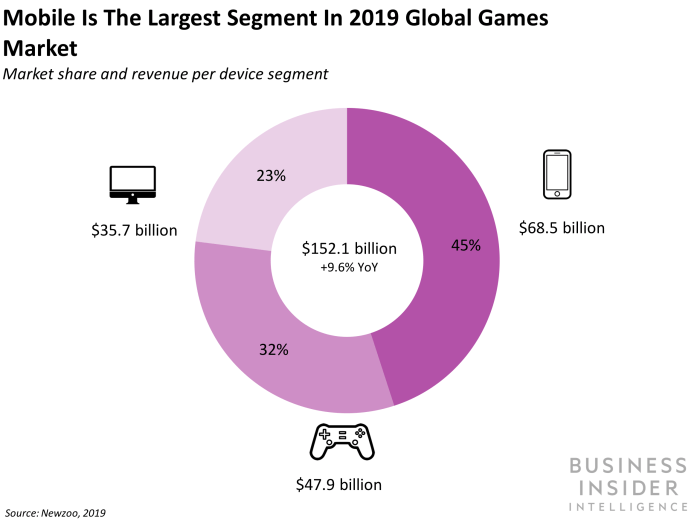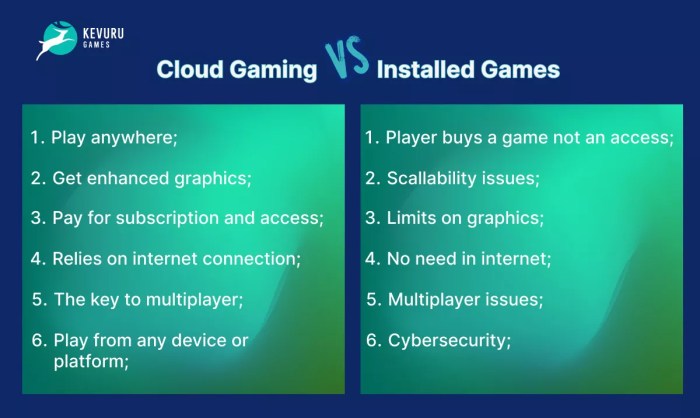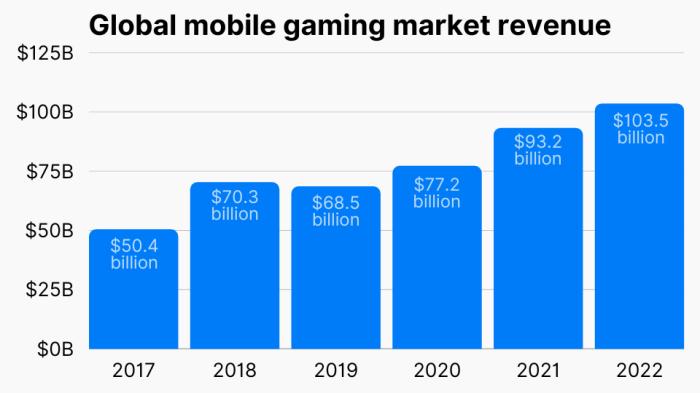Cloud Gaming Vs Local Gaming Pros And Cons
Cloud gaming vs local gaming pros and cons presents a compelling comparison of two distinct gaming paradigms. Cloud gaming offers accessibility and flexibility, while local gaming prioritizes immersion and control. This exploration delves into the core differences, performance considerations, costs, user experiences, and future trends of each approach, ultimately helping gamers decide which method best suits their needs.
This detailed analysis will explore the hardware requirements, internet connectivity needs, typical performance characteristics, and associated costs for each type of gaming. We’ll examine how factors like latency, frame rates, and resolution impact the overall user experience. The comparison will also consider the potential future developments in both cloud and local gaming technologies.
Introduction to Cloud Gaming and Local Gaming
Cloud gaming and local gaming represent distinct approaches to enjoying video games. Cloud gaming leverages remote servers to stream game content, while local gaming relies on the player’s personal computer or console. This fundamental difference impacts various aspects, from hardware requirements to the gaming experience itself. Understanding these distinctions is crucial for making informed choices based on individual needs and preferences.The core difference lies in where the processing power and data storage reside.
Cloud gaming offloads these tasks to a centralized network of servers, while local gaming relies entirely on the player’s personal hardware. This shift in responsibility affects performance, convenience, and the overall gaming experience. Ultimately, both approaches offer unique benefits and drawbacks, leading to a rich spectrum of gaming possibilities.
Fundamental Differences
Cloud gaming and local gaming differ significantly in their technical underpinnings. A comparison table highlights these distinctions:
| Feature | Cloud Gaming | Local Gaming | Comparison |
|---|---|---|---|
| Hardware Requirements | Low; primarily relying on a capable internet connection and a compatible device for streaming. | High; demanding a powerful computer or console with sufficient processing power and graphical capabilities. | Cloud gaming requires minimal local hardware, while local gaming necessitates significant investment in powerful hardware. |
| Internet Connectivity | Essential; a stable and high-speed internet connection is vital for smooth gameplay. | Not Required; local gaming operates entirely independent of internet access. | Cloud gaming is wholly dependent on a functioning internet connection, unlike local gaming. |
| Latency | Variable; latency, or the delay between actions and visual feedback, can fluctuate based on network conditions. | Minimal; latency is minimal, as the game processing occurs locally, resulting in a seamless and responsive experience. | Latency in cloud gaming can be a significant factor affecting gameplay, while local gaming experiences minimal lag. |
Cloud Gaming Technologies
Cloud gaming relies on a complex interplay of technologies. The most crucial elements include:
- Server-Side Processing: Powerful servers handle the game’s computations, graphics rendering, and data storage, freeing the user’s device from these demanding tasks.
- Streaming Protocols: Specialized protocols, such as those based on UDP or custom solutions, efficiently transmit game data from the servers to the user’s device, ensuring a smooth and responsive experience.
- Client-Side Rendering: The client-side application on the user’s device receives and displays the rendered game data, creating the visual experience.
These elements work together to deliver a gaming experience that minimizes the demands on the user’s hardware, allowing them to enjoy games on a wider range of devices.
Local Gaming Technologies
Local gaming involves the direct use of the player’s hardware.
- Local Processing: The player’s computer or console handles all the calculations, graphics rendering, and game logic. This processing power is localized, within the player’s own device.
- Direct Access: The game is installed and runs directly on the player’s hardware, offering complete control and eliminating the need for a constant internet connection.
- Dedicated Hardware: Powerful GPUs, CPUs, and storage solutions are vital for high-performance gaming. These components work in tandem to produce the desired gaming experience.
Local gaming’s strengths lie in its responsiveness and the freedom from internet dependence. However, it necessitates significant upfront investment in high-end hardware.
Performance Considerations
Cloud gaming and local gaming offer distinct performance characteristics, impacting the gaming experience in various ways. Understanding these differences is crucial for choosing the best option based on individual needs and preferences. Factors like internet speed, server load, and hardware configurations play a significant role in determining the quality of the gameplay experience.Cloud gaming, relying on remote servers, introduces inherent performance challenges, whereas local gaming offers consistent performance tied directly to the user’s hardware.
The performance trade-offs are central to choosing the optimal gaming method.
Performance Characteristics Comparison
Cloud gaming typically boasts a variable frame rate, meaning the rate at which images are displayed on the screen can fluctuate depending on server capacity and internet conditions. Conversely, local gaming provides a consistent frame rate, directly correlated to the graphical processing power of the user’s hardware. Resolution in cloud gaming is dependent on the server’s capabilities and the bandwidth available, which might differ from the desired resolution.
Local gaming’s resolution is dictated by the graphics card’s capacity, offering more control over the visual experience. Latency, the delay between an action and its visual representation, is notably higher in cloud gaming due to the transmission time between the player’s input and the server’s response. Local gaming, with its direct connection, experiences minimal latency, leading to a more responsive and immersive experience.
Potential Bottlenecks in Cloud Gaming
Several factors can hinder the performance of cloud gaming. One key bottleneck is internet speed. Insufficient bandwidth can result in dropped frames, stuttering, and a less-than-ideal gameplay experience. High server load, when many users are accessing the same server simultaneously, can also lead to performance degradation. This is similar to a busy highway with slow-moving traffic.
The more users, the slower the experience for everyone.
Impact of Hardware Configurations on Local Gaming
Local gaming performance is directly tied to the hardware configuration of the user’s system. A powerful graphics card, for example, can handle higher resolutions and more complex graphical settings, leading to a smoother, more detailed gaming experience. High-end processors and large amounts of RAM are also important to manage the intensive processing demands of modern games. The more powerful the components, the higher the quality of gameplay.
Performance Metrics and Impact
| Metric | Cloud Gaming | Local Gaming | Impact |
|---|---|---|---|
| Frame Rate | Variable, dependent on server and internet | Consistent, dependent on hardware | Cloud gaming’s frame rate fluctuations can lead to a less smooth experience, whereas local gaming offers a consistent, stable experience. |
| Resolution | Dependent on server resources and bandwidth | Dependent on hardware (graphics card) | Cloud gaming’s resolution might be limited by the server, while local gaming allows for higher resolutions based on the user’s graphics card capabilities. |
| Latency | Higher, due to network transmission | Lower, due to direct connection | Higher latency in cloud gaming can affect responsiveness and immersion, while local gaming provides a near-instantaneous response. |
Cost Analysis

Source: insiderintelligence.com
Cloud gaming and local gaming differ significantly in their cost structures. Understanding these differences is crucial for making an informed decision about which approach best suits individual needs and budgets. A comprehensive cost analysis considers both upfront and ongoing expenses.Analyzing the financial implications allows for a clear comparison of the two gaming models, ultimately helping users make a more informed choice.
Cloud Gaming Costs
Cloud gaming services typically involve a recurring subscription fee, which can vary depending on the service and the level of included features. This subscription fee usually covers access to a library of games and the cloud gaming platform itself. Beyond the subscription, data usage can add to the overall cost, especially for high-resolution or complex games, which often require substantial bandwidth.
High-speed internet connections are essential for a smooth cloud gaming experience, and costs associated with internet service must be factored into the total expense. For example, a user with a slow or unreliable internet connection will experience frequent lag and buffering, diminishing the gaming experience.
Local Gaming Costs
Local gaming, on the other hand, involves upfront costs associated with purchasing hardware components like a gaming-grade computer. This includes a high-performance graphics card, a powerful processor, and ample RAM. Software, such as operating systems and game licenses, also contributes to the initial setup expenses. While the upfront costs are substantial, the ongoing expenses for local gaming are relatively low, primarily consisting of software updates and occasional hardware maintenance.
For instance, a player may need to purchase new game licenses, but the recurring costs associated with hardware are usually minimal.
Cost Breakdown Comparison, Cloud gaming vs local gaming pros and cons
| Cost Category | Cloud Gaming | Local Gaming | Explanation |
|---|---|---|---|
| Initial Setup | Low (Subscription) | High (Hardware) | Cloud gaming typically only requires a subscription, while local gaming demands significant upfront investment in hardware. |
| Ongoing Costs | Recurring (Subscription, Data Usage) | Low (Software Updates) | Cloud gaming has recurring subscription and data usage fees, while local gaming primarily involves software updates and occasional hardware maintenance. |
User Experience

Source: kevurugames.com
The user experience (UX) is a critical factor in determining the appeal and practicality of both cloud and local gaming. It encompasses everything from initial setup to the actual gameplay experience, influencing player satisfaction and long-term engagement. Understanding the pros and cons of each approach is vital for making an informed decision.
Accessibility and Convenience
Cloud gaming’s accessibility is a significant advantage. Users can access games on a vast array of devices, from smartphones and tablets to laptops with minimal hardware requirements. This eliminates the need for powerful gaming PCs, making gaming more accessible to a broader demographic, including those with limited budgets or less-powerful devices. Furthermore, cloud gaming often involves simple sign-up and login procedures, streamlining the setup process and minimizing the initial learning curve.
Conversely, local gaming, while offering a deeper and more tailored experience, requires a specific level of hardware and software compatibility. This can be a barrier for users without appropriate gaming PCs, potentially increasing the entry cost and requiring technical proficiency to set up and maintain.
Immersion and Control
Local gaming provides an unparalleled level of immersion. Direct control over the gaming experience, with a physical keyboard and mouse or a high-quality controller, provides players with an intuitive and responsive experience. The consistent, high-quality visuals and sound output often experienced with local gaming, particularly on high-end hardware, enhance the sense of presence and engagement within the game world.
In contrast, cloud gaming, while offering access to a wide range of titles, can sometimes be hampered by latency issues and limitations in resolution and frame rates, potentially diminishing the sense of immersion compared to local gaming. These limitations are often dependent on the specific cloud gaming platform and the quality of the connection.
Table Contrasting User Experience Elements
| User Experience Element | Cloud Gaming | Local Gaming | Elaboration |
|---|---|---|---|
| Accessibility | High (Minimal Hardware) | Moderate (Specific Hardware) | Cloud gaming’s lower hardware requirements allow for gaming on a wider range of devices. Local gaming necessitates specific hardware configurations, potentially limiting access. |
| Immersion | Moderate (Dependent on Resolution) | High (Direct Control) | The experience depends heavily on factors like connection stability, resolution, and frame rate. Local gaming provides a highly immersive experience due to the direct control and responsive feedback. |
| Convenience | High (Easy Setup, No Maintenance) | Moderate (Setup and Maintenance) | Cloud gaming simplifies the setup process. Local gaming requires maintenance of hardware and software updates, which can be time-consuming. |
| Control | Moderate (Dependent on Input Method) | High (Direct Control) | Cloud gaming control depends on the input method and the cloud platform’s responsiveness. Local gaming offers complete control over the game through the player’s chosen input devices. |
Future Trends
The landscape of gaming is rapidly evolving, with both cloud and local gaming technologies poised for significant advancements. Predicting the precise future is challenging, but examining current trends and potential innovations provides a glimpse into the next generation of gaming experiences. These advancements promise to redefine accessibility, performance, and the overall gaming experience.The future will see a convergence of cloud and local gaming, offering players the best of both worlds.
This synergy will lead to enhanced features and potentially blur the lines between the two approaches. The key to success lies in optimizing performance, reducing latency, and maintaining a satisfying user experience.
Potential Cloud Gaming Developments
Cloud gaming services are expected to become more sophisticated, offering higher resolutions, improved frame rates, and enhanced control schemes. AI-powered optimizations will become increasingly important for tailoring the experience to individual player preferences and network conditions. This will also lead to improved scalability, allowing cloud gaming providers to handle larger numbers of concurrent users and diverse games without sacrificing quality.
Emerging Trends in Local Gaming Hardware
Local gaming hardware is continuously evolving, with an emphasis on smaller, more efficient devices. The demand for compact, powerful PCs and high-performance peripherals, like advanced controllers and VR headsets, will likely persist. The focus on improved cooling and energy efficiency will be a driving force, leading to sleeker designs and better performance per watt. Furthermore, advancements in solid-state storage will enable faster loading times and more responsive gameplay.
The introduction of new materials and manufacturing techniques could lead to even more innovative designs.
A Vision for the Future of Gaming
The future of gaming will likely involve a blend of cloud and local experiences. Players will be able to choose between streaming demanding titles from the cloud or immersing themselves in a high-performance local setup, depending on their specific needs and preferences. The development of seamless transitions between these modes will be key to providing a consistent and enjoyable gaming experience.
For instance, players could use cloud gaming for less demanding games and local gaming for intensive titles or games requiring a specific level of performance.
Potential Future Innovations
- AI-Powered Game Optimization: AI algorithms will dynamically adjust game settings to optimize performance based on individual player preferences and network conditions, offering a personalized and responsive experience.
- Enhanced Cloud Gaming Resolutions and Frame Rates: Cloud gaming providers will likely strive to offer higher resolutions and smoother frame rates, leading to more immersive and visually appealing experiences.
- Improved Cloud Gaming Latency: Reducing latency will be a critical focus, ensuring a more responsive and fluid gaming experience for cloud-based games.
- Seamless Transitions Between Cloud and Local: The ability to seamlessly transition between cloud and local gaming will be a crucial feature, allowing players to switch modes based on their needs and the game in question.
- More Compact and Powerful Local Gaming PCs: Local PCs will continue to become more compact and powerful, maintaining a strong market segment for high-performance gaming experiences.
- Advancements in VR and AR: Virtual and Augmented Reality technology will likely integrate further into gaming experiences, with more immersive and interactive gameplay opportunities emerging.
Final Wrap-Up: Cloud Gaming Vs Local Gaming Pros And Cons

Source: headphonesaddict.com
In conclusion, the choice between cloud and local gaming hinges on individual priorities. Cloud gaming excels in accessibility and affordability, while local gaming offers unparalleled immersion and control. The future promises continued innovation in both areas, potentially blurring the lines between these two approaches. Ultimately, the optimal gaming experience depends on the balance of factors like performance, cost, and personal preferences.













Post Comment